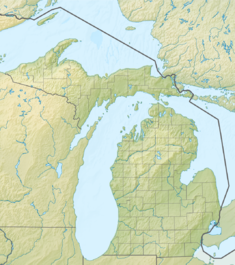
The Au Sable River in Michigan, United States runs approximately 138 miles (222 km) through the northern Lower Peninsula, through the towns of Grayling and Mio, and enters Lake Huron at Au Sable. It is considered one of the best brown trout fisheries east of the Rockies and has been designated a blue ribbon trout stream by the Michigan Department of Natural Resources. In French, au sable literally means "at the sand." A 1795 map calls it the Beauais River.

The BC Hydro and Power Authority is a Canadian electric utility in the province of British Columbia, generally known simply as BC Hydro. It is the main electricity distributor, serving 1.8 million customers in most areas, with the exception of the City of New Westminster, where the city runs its own electrical department and the Kootenay region, where FortisBC, a subsidiary of Fortis Inc. directly provides electric service to 213,000 customers and supplies municipally owned utilities in the same area. As a provincial Crown corporation, BC Hydro reports to the BC Ministry of Energy and Mines, and is regulated by the British Columbia Utilities Commission (BCUC). Its mandate is to generate, purchase, distribute and sell electricity.

Hydroelectricity is electricity produced from hydropower. In 2015, hydropower generated 16.6% of the world's total electricity and 70% of all renewable electricity, and was expected to increase by about 3.1% each year for the next 25 years.

Hydro Tasmania, known for most of its history as the Hydro-Electric Commission or The Hydro, is the trading name of the Hydro-Electric Corporation, a Tasmanian Government business enterprise which is the predominant electricity generator in the state of Tasmania, Australia. The Hydro was originally oriented towards hydro-electricity, due to Tasmania's dramatic topography and relatively high rainfall in the central and western parts of the state. Today Hydro Tasmania operates thirty hydro-electric and one gas power station, and is a joint owner in three wind farms.
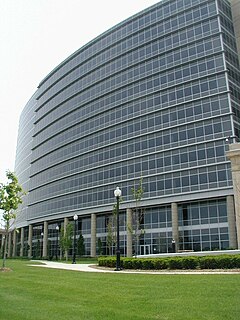
CMS Energy, based in Jackson, Michigan, is an energy company that is focused principally on utility operations in Michigan. Its principal business is Consumers Energy, a public utility that provides electricity and natural gas to more than 6 million of Michigan's 10 million residents. Its non-utility businesses are focused primarily on domestic independent power production. Consumers Energy has operated since 1886.

Consumers Energy is a public utility that provides natural gas and electricity to 6.7 million of Michigan's 10 million residents. It serves customers in all 68 of the state’s Lower Peninsula counties. It is the primary subsidiary of CMS Energy. The company was founded in 1886 and is currently headquartered in Jackson, Michigan.

Run-of-river hydroelectricity (ROR) or run-of-the-river hydroelectricity is a type of hydroelectric generation plant whereby little or no water storage is provided. Run-of-the-river power plants may have no water storage at all or a limited amount of storage, in which case the storage reservoir is referred to as pondage. A plant without pondage is subject to seasonal river flows, thus the plant will operate as an intermittent energy source. Conventional hydro uses reservoirs, which regulate water for flood control and dispatchable electrical power.
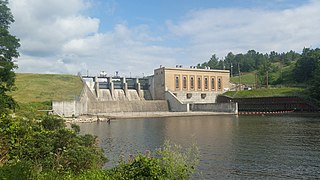
Tippy Dam or Tippy Hydro was built 1918 and is a hydroelectric dam operated by Consumers Energy. The original name of the dam was Junction Hydro, but it was renamed to honor a Consumers board of directors member, Charles W. Tippy. The dam spans the Manistee River about 170 miles from its headwaters which include Manistee Lake, on the river's way to Lake Michigan.
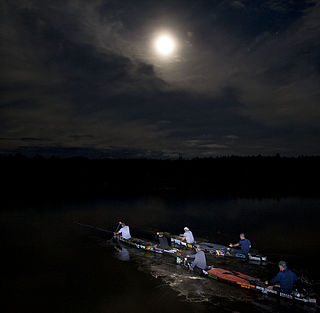
The Au Sable River Canoe Marathon, presented by Consumers Energy, is an annual 120 mi (193 km) canoe race in Michigan from Grayling to Oscoda. Nicknamed and known simply as "The Marathon," it first ran in 1947, and is perhaps the oldest marathon canoe race in the United States, and is the longest, non-stop, canoe-only race in North America. The race has been billed as "The World's Toughest Spectator Race" as many of the spectators follow the racers overnight down the full 120 miles (190 km) to the finish.

Croton Dam is an earth-filled embankment dam and powerplant complex on the Muskegon River in Croton Township, Newaygo County, Michigan. It was built in 1907 under the direction of William D. Fargo by the Grand Rapids - Muskegon Power Company, a predecessor of Consumers Energy. The 40-foot-high (12 m) dam impounds 7.2 billion U.S. gallons (6 billion imp. gal/27 billion L) of water in its 1,209-acre (489 ha) reservoir and is capable of producing 8,850 kilowatts at peak outflow. It was listed on the National Register of Historic Places in 1979.

The Jordan River Dam, officially the Jordan River Diversion Dam, and known locally simply as Diversion Dam, is a dam located in Jordan River, British Columbia, Canada. It is part of the second hydroelectric development on Vancouver Island.

Lake Pieman is a man-made reservoir created by the damming of the Pieman River, located in the West Coast region of Tasmania, Australia.
The Anthony Power Development Scheme, part of the Pieman River power development scheme, was a proposed scheme for damming parts of the upper catchment of the Pieman River in Western Tasmania, Australia.

Trị An is a hydroelectric dam and lake on the Đồng Nai River in Vĩnh Cửu, Đồng Nai, Vietnam. The power plant has an installed electric capacity of 400 MW and producing around 1.76 TWh of electricity per year. The plant is operated by Trị An Hydropower Company, a subsidiary of Vietnam Electricity.

Hardy Dam is an earth-filled embankment dam and powerplant complex on the Muskegon River in Big Prairie Township, Newaygo County, Michigan. At the time of its completion, it was the largest earthen dam in North America east of the Mississippi. Its impoundment forms a lake with over 50 miles of shoreline. The dam impounds a reservoir with a surface area of 4,000 acres and its power plant has an installed capacity of 31.5 MW.
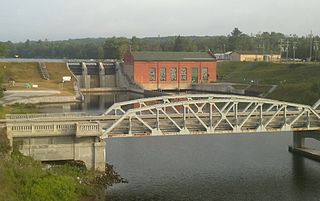
Five Channels Dam is a hydro-electric dam on the Au Sable River in Michigan.

Alcona Dam is a hydro-electric dam on the Au Sable River in Michigan.
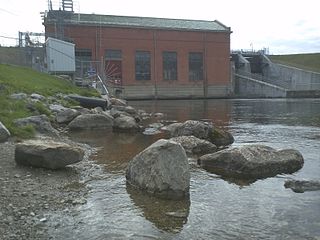
Cooke Dam is a hydro-electric dam on the Au Sable River in Michigan. It was listed on the National Register of Historic Places in 1996 as the Cooke Hydroelectric Plant.
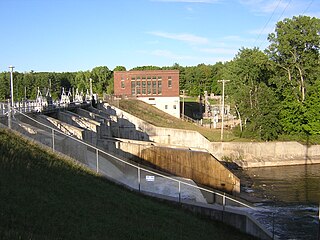
Rogers Dam is an earth-filled embankment dam on the Muskegon River in Mecosta Township, Michigan, United States. It is located about six miles (9.7 km) south of Big Rapids. Construction of the dam began in 1905, and its power plant was commissioned in March 1906. Owned and operated by Consumers Energy, the primary purpose of the dam is hydroelectric power generation. On December 22, 1921, the original 4.5-megawatt (6,000 hp) power plant was destroyed in a fire. It was rebuilt with an increased 6.8-megawatt (9,100 hp) installed capacity in 1922. The rebuild cost approximately $450,000. It is the oldest hydroelectric power plant operated by Consumers Energy who owns the Hardy and Croton dams downstream of Rogers Dam.

